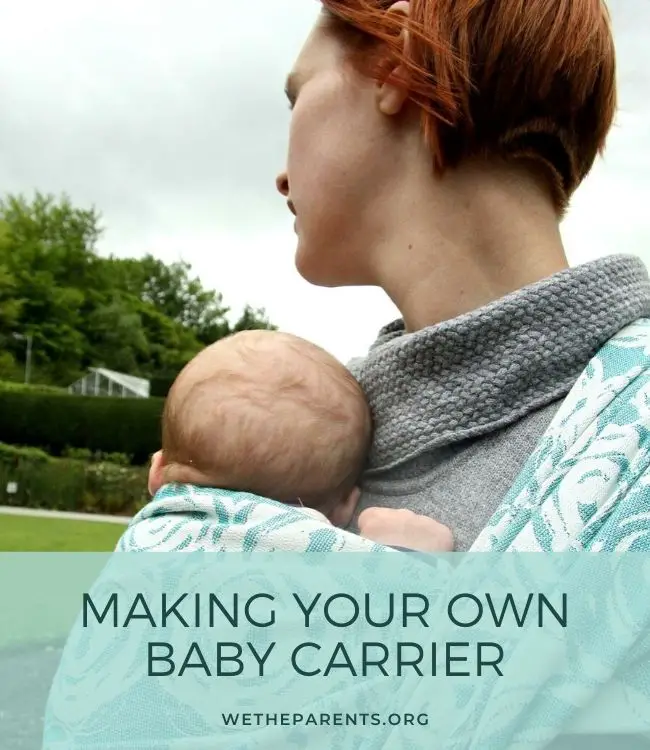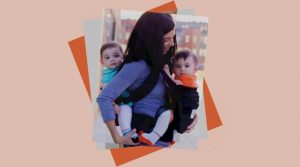Babywearing is a long-used practice that has many benefits for both parents and baby, but the price tag attached to quality wraps, slings, and soft-structured carriers can be prohibitive for some parents.
If you’re crafty and handy with the sewing machine, you may have wondered if it’s possible for you to safely make your own carrier. The answer? Absolutely!
Check out our lowdown on babywearing benefits and popular carrier styles, and then dive into five handy tutorials for making your own babywearing carrier.
What are the benefits of babywearing carriers?
As we noted, there are a multitude of benefits reaped by both parents and baby during babywearing. Here are a few major selling points:
- It allows newborns to have the skin-to-skin contact that’s so vital to their healthy early development, facilitating bonding with parents; this bond also triggers the release of oxytocin in mothers, which can improve mood and make breastfeeding easier.
- From the standpoint of simple convenience, wearing your baby frees up your hands to do other things; this can save you a lot of time that would otherwise be spent holding baby in place to comfort them or allow them to nurse.
- It’s a lot less hefty than a cumbersome stroller, which can make traveling with your baby much easier.
What kinds of babywearing carriers exist?
Wraps
Made of a long piece of durable fabric, these carriers are often ideal for sharing between partners. They can be used to perform all babywearing carries, but they’re a bit more complex to get the hang of than similar carriers like slings and mei tais.
Mei Tais
This carrier style combines a soft-structured seat that makes it easy to situate baby with long fabric ties for securing the carrier. It’s multi-positional and fairly easy to use, and as long as the ties are long enough, it’s a good carrier style for sharing.
Slings
Virtually foolproof in use, slings are one of the most popular types of babywearing carrier. Two types exist — those that simply slip on, which are made out of a pre-constructed fabric loop, and those that are secured by rings, which are made out of a long strip of fabric. The former are perhaps the easiest babywearing carrier to put on, but they’re far less forgiving in size when sharing between wearers than the latter.
Soft-Structured carriers
This is the only type of carrier that’s not really possible to make on your own, as it relies on buckles, padded straps, and adjustable mechanisms to secure baby in the carrier and achieve a good fit. They’re convenient in use, easy to share, and some of the most likely picks to have convenience features like pockets and weather hoods, making them arguably the best baby carrier for hiking and other outdoor activities, but they’re also some of the priciest babywearing carriers out there.
Related: Baby Carriers vs. Wraps vs. Slings: An Easy yet Expert Guide
Making your own baby carrier
DIY Reversible Mei Tai Carrier
We won’t lie, this project is one that’s best for parents who know their way around their sewing machine. However, it’s well worth the work, as it’s an adorable project that boasts reversibility as an advantage. It also requires surprisingly few supplies, making the finished product a great deal cheaper than the average mei tai.
Difficulty level: Intermediate
You’ll need:
- Sewing machine
- Straight pins
- Iron
- Scissors
- Measuring Tape
- Large piece of paper for pattern
- Fabric marker
- 3.5 yards of desired fabric for straps
- Two pieces of body fabric, 2/3 yards each, different styles for a reversible carrier)
- Thermal adhesive no-sew interface for connecting the body, like Heat’n Bond
Steps:
- Draw and cut out a body pattern on your piece of paper. The tallest portion should be 19″, the middle should be 13.75″, the bottom should be 16.5″, and the top should be 9.5″ with angled 5″ corners
- Use the pattern to carefully cut out a body panel from each of your chosen body fabrics as well as two pieces of Heat’n Bond or thermal adhesive no-sew interfacing
- Create fabric strips for your straps by cutting two 22″ x 80″ panels and two 11″ x 32″ panels
- One by one, lay your fabric body panels on your ironing board, pattern or color facing down. Take the interfacing panels and place them with the textured side against your fabric. Heat them with the iron, following the product’s temperature directions.
- Repeat step 4 exactly in order to create your second body piece.
- To create your straps, fold the pieces you’ve cut longwise, facing the right sides inward, and pinning to secure your fold.
- Connect the long side of the piece from end to end with your sewing machine. Connect one short end, but leave the other open, creating a long fabric tube.
- Gently and carefully, reverse the strap so that it is no longer inside out. Flatten it with the iron, and secure the straps further by top stitching around the entire perimeter.
- Repeat step 8 exactly in order to create three more straps.
- Each strap will have one side which is not fully finished. Take one of the two short straps and create a pleat at that end, and then place it on the right side of a body panel, maintaining about a half inch of room for the seam. Repeat this process with the other short strap on the left side of the panel.
- Repeat this process with the long straps, placing them at the shoulder section of the body panel.
- Take the end of each strap and fold it so that it lays in the middle of the body panel.
- Take your other body panel and place it on top, ensuring that like colors or patterns are both facing inward. You should be able to see the ends of your straps poking out — this is a good thing, as it means they’re long enough to safely account for baby’s weight.
- Use straight pins to connect the edges of the two body panels, and then connect the edges with your sewing machine. Do leave a space of about half a foot in order to allow you to reverse the carrier.
- Using your shears, gently trim any extra fabric left near your seams.
- Reverse the carrier, and iron it in order to smooth any creases and perfect the shape.
- Finally, secure the body piece for wear by top stitching the perimeter of the body panel two times.
Related reading: Best Mei Tai Baby Carriers Of 2021
The Fauxby: A DIY Moby Wrap
Moby wraps are beloved by moms for the comfort and security they offer during babywearing, but understandably, they aren’t cheap. Only the most basic sewing skills are needed to make this project, which utilizes a handy patch to help you find the center of the wrap by touch. Your fabric buy will also net you two wraps, which can be seriously handy — babies are messy.
Difficulty level: Beginner
You’ll need:
- A five yard piece of fabric of your choosing; generally, a piece this size can make two wraps. You may want to have the clerk at your craft store cut the fabric, which is a free service. Muslin works great for this project
- A patch made out of a fabric with a different texture
- Sewing machine
- Fabric shears
- Iron
- Straight pins
- Thermal adhesive no-sew interface like Heat’n Bond
Steps:
- If you didn’t have it done at the craft store, cut your fabric square into two panels measuring 20″ x 5 yards.
- Use your iron to flatten a hem around the edges of your wrap. Use straight pins to secure the edges, and then sew around the perimeter.
- Cut two patches of thermal interface that are the exact size of your patch. Place the first texture-side down in the middle of your wrap. Place the second piece directly on top, texture side up. Finally, place your patch on top, and iron to secure. This patch will help you find the center of the wrap by touch without struggle.
Related: The Best Baby Wearing Shirts To Carry Your Baby
DIY Baby K’tan: No craft skills required
One reason parents love Baby K’tan is how easy it makes babywearing. There’s no learning to fold and tie a wrap, but there’s still none of the bulk of a soft structured carrier. If the price tag is prohibitive, check out this no-sew alternative that legitimately requires no crafting skills whatsoever.
Difficulty level: Beginner
You’ll need:
- Two t-shirts without seams on the sides
- Fabric shears
- Long scarf
Steps:
- Using your fabric shears, cut each t-shirt in half just below the armpit. You will need the bottom half of the shirts, which will look like two fabric loops.
- Take one loop and place it over your shoulder like a sash, so it crosses your chest.
- Repeat this process with the other loop, placing it on your other shoulder.
- To wear baby, tuck them into the inner fabric loop, crossing the other loop over it to secure baby. e sure to follow TICKS guidelines: Tight; In view at all times; Close enough to kiss;Keep chin off chest: Supported Back. 1The T.I.C.K.S Rule for Safe Babywearing
Easy DIY sling
Slings offer comfort and ease during babywearing, and they don’t always require rings to be both secure and good for sharing between wearers. This no-sew DIY carrier uses a simple slip knot to secure your hold on baby.
Difficulty level: Beginner
You’ll need:
2.5 yards of fabric of your choosing
Steps:
- Take your piece of fabric and spread it across your back on a diagonal angle, with one end draping over your right shoulder and the other wrapping around your left side.
- Evenly gather both the length of the fabric over your shoulder and the tail draping around your side, and make sure the fabric across your back remains flat and does not twist.
- Create a slip knot which will secure the sling by bringing the lower tail up behind the shoulder piece, and then allowing it to hang down. Move the lower tail under and over the shoulder piece once again, and then move the fabric through the loop that has been created in order to finish.
- Test the veracity of your knot by attempting to move the fabric up and down several times.
- Loosen the fabric of the main body in order to create baby’s sitting pouch.
Related: The Best Ring Slings You Can Buy in 2021
The ultimate one-cut, no-sew DIY baby wrap
If you are absolutely, positively not an arts-and-crafts person, you’ll be made in the shade with this DIY carrier. It’s not quite as professional-looking as the other projects on our list, but if you pick a fabric that looks nice with an intentionally frayed hem like a muslin blend, you’ll be able to spot few differences between this super simple pick and a standard prefabricated wrap. Bonus: Your five-yard piece of fabric will actually make two wraps!
Difficulty level: Give your baby a year, and they can do it (just kidding, but… honestly!)
You’ll need:
- Five yards of a fabric of your choosing (something with light stretch is best)
- Fabric sheers
Steps:
Simply cut your fabric lengthwise into a strip that’s 21″ wide and five yards long. No, we didn’t forget the measuring tape — it’s that easy! Just fold your fabric in half lengthwise and cut along the fold to create two quick and casual wraps. Follow standard wrapping instructions for use with your little one.
cYou don’t have to be a craft blogger or sewing superstar to make a babywearing carrier that will work for you and your little one, nor do you need to break the bank to experience the magic of babywearing. Your project options are diverse, but be sure to always follow your pediatrician’s recommendation for babywearing and adhere to average height and weight recommendations for carry styles in order to keep your little one safe. Happy DIY-ing!








